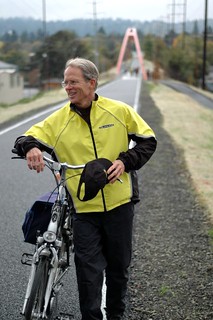This is a guest post by Rex Burkholder, who represents parts of Portland on the council of Metro, our area’s regional government. He is one of the founders of Oregon’s statewide bike advocacy organization, the Bicycle Transportation Alliance, and served as the organization’s first policy director. After reading my Bikenomics zine, in which I discuss some of the economic implications of Portland’s “low hanging fruit” style of bicycle advocacy, he got in touch to set the record straight about how things were done in earlier times. Below is his take on how and why Portland became such a bike-friendly city … and how far we have yet to go.

Photo © Jonathan Maus / BikePortland
Portland has always been a bike friendly place….right?
Lots of people have heard of the “Bike Bill,” passed way back in 1971 during the frenzy of good stuff pushed by Republicans like land use planning, clean air and bottle deposits. The bill required that 1% of state-funded transportation projects be used to build bicycle facilities.
But the real story is actually one of constant struggle and advocacy. It didn’t really didn’t take off until the Bicycle Transportation Alliance was founded in late 1990, almost 20 years after the Bike Bill became law. The intervening years had little to show for them (bike trails along freeways, mostly) in the Portland region. There were no bike lanes on major streets, no safe bridge crossings on the Willamette, no bikes on buses or light rail. And cyclists had no power at Portland City Council, Metro or any of the three counties.
Bicyclists, and there weren’t many, were left to their own devices which sometimes meant your fists, ’cause the cops would never take the cyclists’ side in confrontations with motorists. I remember being ordered off of NE Broadway by a police captain as he idled beside me, even though he couldn’t cite a reason.
The first BTA was a small group of volunteers, meeting in each other’s kitchens to put together strategy, newsletters (photocopied and mailed back then), and vision. And look what we got done throughout the 90s:
- Bikes on transit. Volunteers collected something like 7,000 signatures on the street, got numerous local governments to pass supporting resolutions and did independent research to convince TriMet to try it out for a year. It worked, attracting new customers to the bus, and TriMet become the first large transit agency in the country to become 100% bike accessible. The low floor MAX light rail cars which allowed easier boarding with bikes were another direct outcome of our work — and another first.

The new, improved Broadway Bridge
- Bike-friendly bridges. The BTA went to Multnomah County when we found out they were going to do a major retrofit of the Hawthorne Bridge but weren’t going to do anything to make it better and safer for cyclists (the sidewalks were all of 4 feet wide). The County, under leadership of Chair Beverly Stein, agreed to widen the sidewalks on Hawthorne bridge and commit to fix all 7 Willamette River bridges to make them safer for bikes and walkers, the last being the Morrison. Old timers will remember the wooden sidewalks on the Broadway Bridge. Another win for citizen action!
- First road diet in Portland. BTA action got a lane removed from NE Broadway and Weidler in the Lloyd District, creating space for wider sidewalks and bike lanes. This was a result of our grassroots “restore the boulevard” campaign to get bike lanes on SE Hawthorne (alas, the City never followed through on promises to make Hawthorne bicycle friendly even though studies show that a three-lane configuration is better for driving, transit, and cycling. In Minneapolis, the mayor made a commitment to road diets, and that is why they, not Portland, are now the #1 bicycle city in America).
- Beat the City in court. Successfully sued the City of Portland (all the way to Oregon Supreme Court) to implement the Bike Bill. Contrary to some accounts, the lawsuit wasn’t specious or a failure or a minor issue, it was about whether Portland (and all other governments in Oregon) was going to meet its legal obligation to cyclists under ORS366.514. The BTA deliberately chose a high profile project–the Oregon Arena–and the critical connections to the Broadway Bridge. Current Congressman Earl Blumenauer was transportation commissioner at the time and boy, he wasn’t happy at being sued, but the courts proved the BTA was right. Much of the incredible growth in bike and ped infrastructure since then is due directly to this landmark case (BTA vs. City of Portland).
These victories were won through imagination, hard work and not taking no for an answer. Critical Mass never came to much here was precisely because the BTA was so effective, especially through grassroots organizing. We were a critical mass, growing from a few people around the kitchen table to thousands through effective, principled and relentless advocacy. The BTA also were active supporting advocates around the state with training, logistical help and ideas.
The bicycle as transport has an even greater role to play in maintaining effective mobility and access while taking on climate change, peak oil, and other struggles for the world’s resources. What other way of getting around is so healthful, safe, clean, equitable and enjoyable?
Yet big transportation projects in Portland are still being built without bike facilities, for example, the current rebuild of Martin Luther King Boulevard and Grand Avenue for the streetcar, or the upcoming rehabilitation of the St Johns Bridge, as well as the 20+ year wait for decent bike access on main streets like Burnside, 28th, Hawthorne, Halsey, etc, etc, etc.
It is time again for strong, outspoken citizen action in Portland.
This is a guest post by Rex Burkholder.